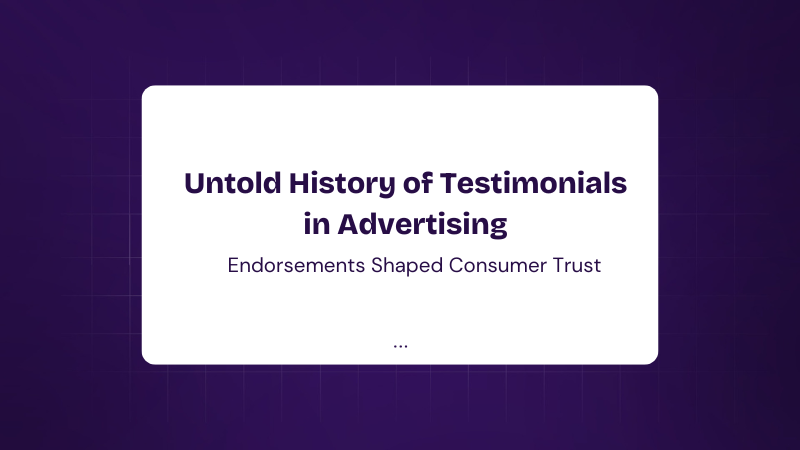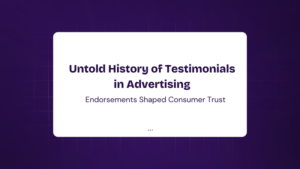The Power of Testimonials – A Marketing Love Affair
Picture this: It’s ancient Rome, and a street vendor is passionately shouting about how his olive oil is the best in town. Suddenly, a respected senator steps forward, praises the oil, and assures everyone it’s the finest he’s ever tasted. Instantly, the vendor’s sales skyrocket. Congratulations! You’ve just witnessed one of the earliest forms of testimonial advertising.
For as long as people have sold goods and services, testimonials have played a crucial role in persuasion. We trust recommendations—especially when they come from someone we admire, relate to, or perceive as an authority. From ancient civilizations to social media influencers, testimonials have shaped the way we buy and sell. But how did they evolve from simple word-of-mouth to the powerful digital tools we see today? Let’s dive into history and uncover the fascinating journey of testimonials in advertising.
Ancient Origins: The Birth of Word-of-Mouth Advertising
Before the era of newspapers and billboards, testimonials relied entirely on word-of-mouth. In ancient Egypt, Greece, and Rome, merchants depended on their reputation to attract customers. If a respected member of society endorsed a product, it gained credibility.
Archaeological evidence suggests that Egyptian craftsmen inscribed testimonials from satisfied clients onto their works, ensuring their skills were well-advertised. In Rome, physicians and healers relied heavily on endorsements from aristocrats to build trust. It was the earliest form of influencer marketing—minus the Instagram filters.
The Middle Ages: The Role of Guilds and Royal Endorsements
Fast forward to the Middle Ages, and testimonials became institutionalized through trade guilds. Blacksmiths, weavers, and masons gained credibility by displaying seals of approval from their guilds. It was an early attempt to prevent fraudulent advertising.
At the same time, royal endorsements played a crucial role in influencing public opinion. If the king or queen used a product, it instantly gained prestige. This practice set the stage for modern celebrity endorsements.
The Printing Press Revolution: Testimonials in Early Print Ads
The invention of the printing press in the 15th century revolutionized testimonials. By the 17th century, newspapers were filled with advertisements featuring testimonials for medicines, textiles, and household goods.
One notable example comes from 17th-century England, where “miracle cure” advertisements included endorsements from supposed patients. While some were genuine, others were exaggerated—setting the foundation for later debates on advertising ethics.
The 19th Century: Testimonials in the Age of Industrialization
As industrialization took off, mass production led to increased competition, making advertising more crucial than ever. Testimonials became a staple of marketing, often appearing in newspapers, posters, and pamphlets.
However, this era also saw the rise of fraudulent testimonials, particularly in the health and wellness industry. Snake oil salesmen became notorious for using fake endorsements to sell their dubious remedies. This period marked the beginning of consumer skepticism—a skepticism that continues today.
The 20th Century: The Golden Age of Testimonial Advertising
The arrival of radio and television brought testimonials to life. Suddenly, brands could feature real voices and faces advocating for their products.
Celebrities became the go-to figures for endorsements. Whether it was Marilyn Monroe praising Chanel No. 5 or Michael Jordan promoting Nike, testimonials had entered a golden age. This era also gave birth to the classic infomercial, where enthusiastic “real customers” raved about their life-changing experiences.
The Legal Side: Regulations on Testimonials and Advertising
With great influence comes great responsibility—or at least government intervention. As deceptive advertising became rampant, authorities introduced laws to regulate testimonials.
In the U.S., the Federal Trade Commission (FTC) began enforcing truth-in-advertising laws, ensuring that testimonials were based on real experiences. Today, companies must disclose if testimonials are paid or incentivized, adding transparency to the practice.
The Digital Age: Testimonials in the Era of Social Media
The internet changed everything. Consumer reviews, influencer marketing, and video testimonials became dominant forces in advertising.
Platforms like Amazon and Yelp thrive on testimonials, with millions of customers relying on peer reviews before making purchases. Meanwhile, influencer marketing has given testimonials a new face, with social media personalities endorsing brands in exchange for sponsorships.
Fake Testimonials and the Battle for Authenticity
With digital testimonials came a new challenge: fakes. Companies and individuals began fabricating reviews to manipulate consumers. In response, tech giants like Google and Amazon implemented AI-driven detection systems to combat fraudulent testimonials.
Authenticity remains the key to a successful testimonial campaign. Modern consumers demand genuine experiences, forcing brands to prioritize transparency and credibility.
Case Studies: Brands That Mastered Testimonial Advertising
Some brands have leveraged testimonials to perfection:
- Apple: Customer testimonials played a crucial role in their “Shot on iPhone” campaign, showcasing real user experiences.
- Nike: Athlete endorsements, from Michael Jordan to Serena Williams, have cemented the brand’s dominance.
- Airbnb: User-generated testimonials drive trust and credibility for hosts and travelers alike.
Psychology Behind Testimonials: Why Do We Trust Them?
Why do testimonials work? It all boils down to psychology. Concepts like social proof and cognitive bias explain why we value the opinions of others.
Studies show that 92% of consumers trust peer recommendations over traditional ads. Emotional connection, credibility, and relatability all contribute to the persuasive power of testimonials.
The Future of Testimonials: What’s Next?
The future of testimonial advertising is exciting. Expect to see:
- AI-generated testimonials that feel more human than ever.
- Augmented reality experiences where customers can see real-life use cases.
- Blockchain-based verification to ensure authenticity in reviews.
FAQs
Are testimonials still effective in advertising?
Yes! Studies show that customer reviews and endorsements significantly influence purchasing decisions.
How can businesses ensure their testimonials are trustworthy?
By using real customer experiences, disclosing paid partnerships, and avoiding exaggerated claims.
What’s the difference between a review and a testimonial?
A review is usually unsolicited and detailed, while a testimonial is a curated endorsement.
How do companies combat fake testimonials?
Through AI detection, verification processes, and transparency policies.
Can testimonials backfire?
Yes! If they seem inauthentic, overly scripted, or misleading, they can damage a brand’s credibility.
Testimonials – The Timeless Art of Persuasion
From ancient word-of-mouth recommendations to AI-driven testimonials, one thing remains constant: we trust the experiences of others. Whether it’s a celebrity endorsement, an online review, or a heartfelt customer story, testimonials continue to shape how we perceive brands.
In a world filled with marketing noise, a genuine testimonial remains one of the most powerful tools for persuasion. The challenge for modern brands is ensuring their testimonials stay authentic, relevant, and, most importantly, trustworthy.



